Kanji for Long: 長 (Naga-i)
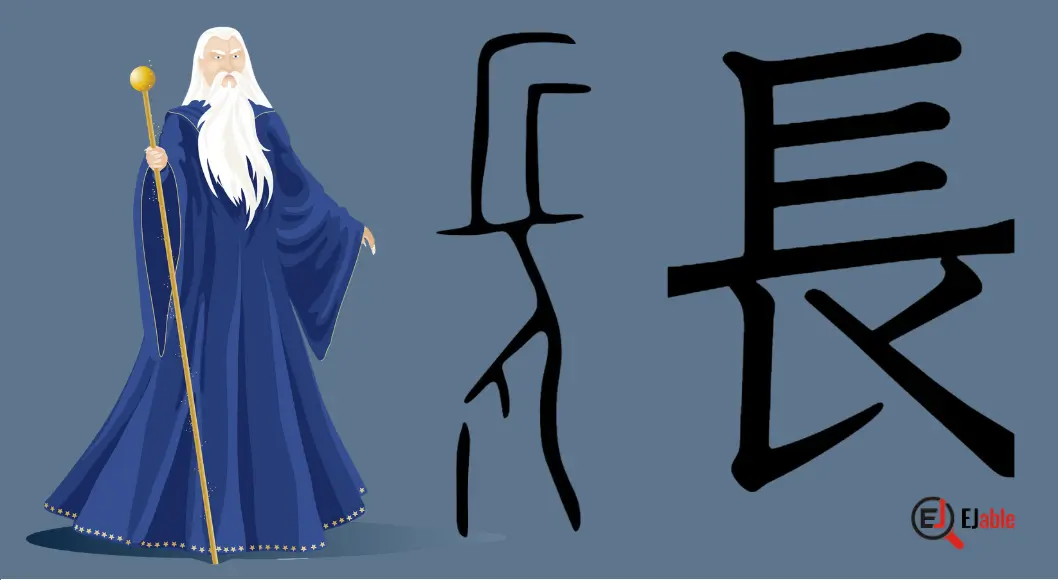
The Japanese kanji for “Long” is 長.
The pronunciation of the Kanji 長 is “naga-i” (なが-い) in its kun’yomi (Japanese reading) and “chou” (チョウ) in its on’yomi (Chinese reading). However, the Kanji 長 is also pronounced as “osa” (おさ) in it’s Japanese reading.
The reading “osa” is for words when this Kanji extends its meaning from long to mean the head of a group, chief, leader, elder, the greatest of all, or the most excellent.
Similarly, the Chinese pronunciation “chou” is used in the words when the Kanji 長 for long is used to indicate positions for leadership, e.g. 社長 (shachou) meaning company president or 部長 (buchou), meaning department head.
In the above examples, the word “long” or “tall” is associated with superiority or higher status, as well as for someone who is in charge.
The Kanji 長 is constructed with 8 strokes. This Kanji is a part of the JLPT N5 syllabus (please check the JLPT N5 Kanji list). In Japanese schools, this Kanji is taught in grade 2.
Origin of the Shape 長
The origin of the Kanji 長 is quite interesting, and the original shape of it depicted both the lengthiness and leadership. Let’s see the evolution of the shape of this Kanji from ancient times to the current:
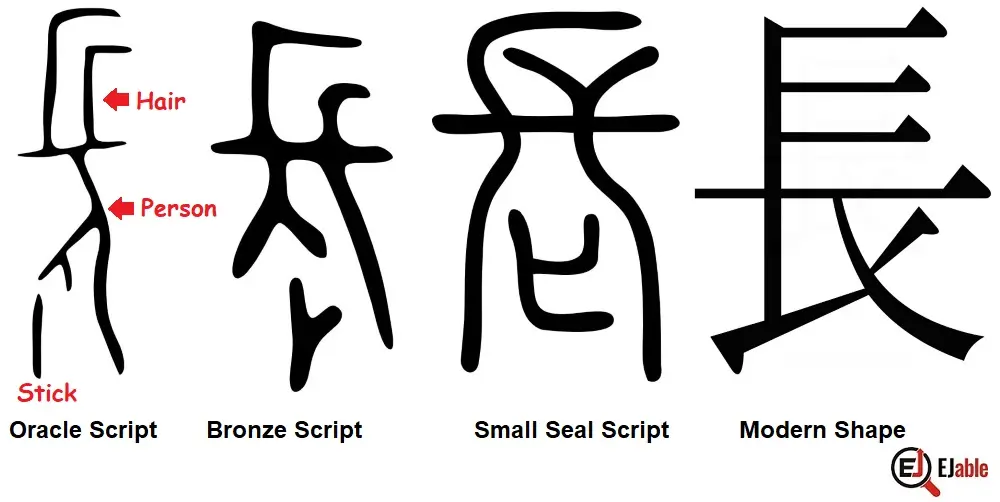

The above image shows the original shape of the Kanji 長 as seen in the old Oracle script, and then in the subsequent phases of bronze script, Small Seal script to how it is written now.
As the shape of this Kanji evolved so greatly, starting from the small seal script days to modern days, it is difficult to explain the transition. However, it’s not really important. What is important is to analyze the very origin, as seen in the Oracle script. Please note that the shape of this Kanji in bronze script days is quite similar to how it was drawn in the Oracle script.
Explanation: 長 as “Long” in Oracle Script
The above illustration is self-explanatory in that it shows a person with long hair holding a cane. However, some may get confused about the person’s shape in this Kanji. To understand it better, please check the “origin” part of the article about the Kanji for person (hito).
Significance of Long Hair and Cane
As the Kanji 長 represents both “Long” and “Leadership”, the ancient shape in the Oracle script indicates a village chief.
During the old days, seniority came with age and experience. The reason was simple: there were practically no other sources to gain knowledge and wisdom other than experience. So, in this shape, the long hair and the cane signify that the person is old and has long experience.
On the one hand, long hair relates to the meaning “Long” of this kanji, and on the other hand, if seen as the complete picture, it indicates a person with long experience, making him the leader, e.g., chief of a clan or village.
Mnemonic: How to Remember the Kanji for Long (長)
As we saw above, the Kanji 長 evolved so greatly from its original shape that it’s quite difficult to remember it by relating it to its origin. Therefore, it is best to have a mnemonic which can make it easy to remember. So, let’s use the following illustration as a mnemonic to remember 長 by relating it to the concept of “Long”:
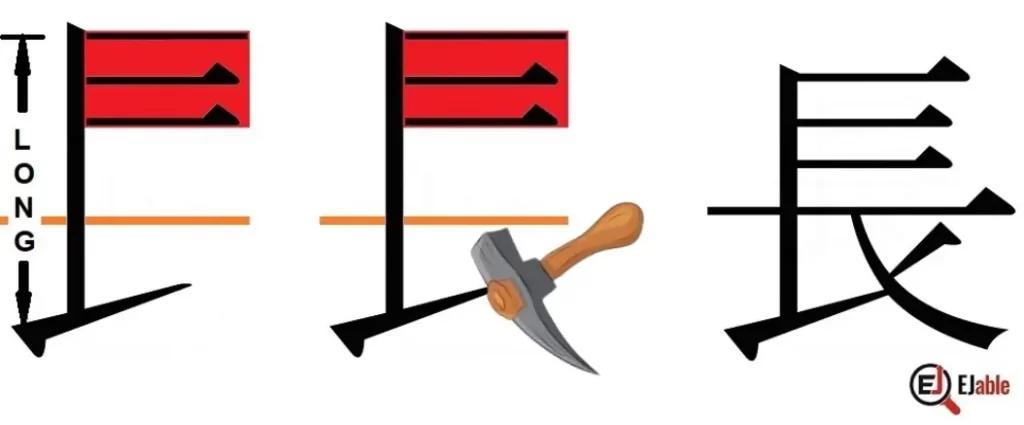

Explanation of the Mnemonic for 長
Consider the left part of this kanji, or the first 6 strokes of it, as a flag mounted on a long pole. In the above illustration, the horizontal brown line represents the ground where you are putting the flag.
Now, as the pole is very “Long,” one has to dig the ground quite deep so that the flag does not fall. Considering this logic, think of the 7th and 8th strokes of this Kanji as a pick axe to dig the ground deeper.
Stroke Order for the Kanji 長
The following illustrations show the stroke order to write the Kanji 長, meaning “long”:
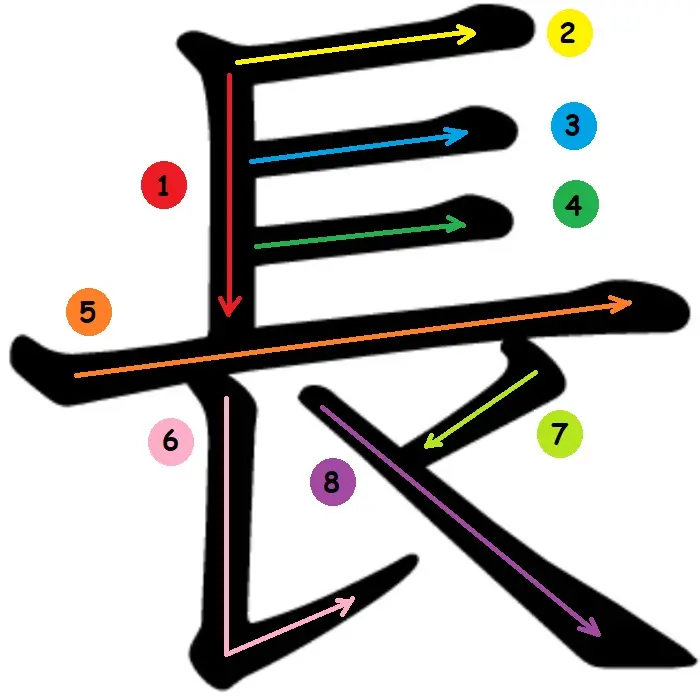

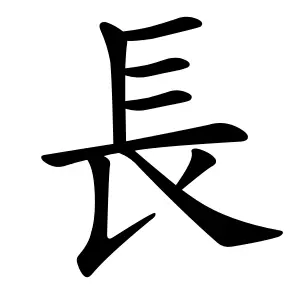

Long (Naga-i) Kanji in Compounded Words
The kanji for “long” 長 (naga-i, なが-い) appears commonly in the Japanese language and forms part of many compound words. There are 278 Japanese words that begin with the Kanji 長, and it appears in 868 words.
Examples of 長 in Compounded Kanji Characters
Following are the examples where the Kanji meaning “Long” appears in Japanese compounded Kanji characters:
- 長期 (ちょうき / chōki): Long term, long period.
- 長所 (ちょうしょ / chōsho): Strength, strong point.
- 長男 (ちょうなん / chōnan): Eldest son.
- 長女 (ちょうじょ / chōjo): Eldest daughter.
- 長老 (ちょうろう / chōrō): Elder, senior.
- 社長 (しゃちょう/shachou): Company president
- 長官 (ちょうかん / chōkan): High-ranking official.
- 校長 (こうちょう / kōchō): School principal.
- 部長 (ぶちょう / buchō): Department head, manager.
- 長話 (ながばなし / nagabanashi): Long talk, lengthy discussion.
- 長寿 (ちょうじゅ / chōju): Longevity.
- 長編 (ちょうへん / chōhen): Long version, full-length (as in a movie or novel).
- 首長 (しゅちょう / shuchō): Leader, head (of a government, etc.).
- 市長 (しちょう / shichō): Mayor.
- 会長 (かいちょう / kaichō): Chairman, president.
- 長靴 (ながぐつ / nagagutsu): Long boots.
These compound words demonstrate the versatile use of the Kanji 長 in various contexts, apart from meaning “long,” from describing physical length or duration to indicating positions of authority or seniority.
長 as a Radical or Component
The Kanji 長, meaning “Long,” is not used as a Kanji radical, but it appears in 19 other Kanji as a component. However, only two of those Kanji characters are Jōyō (common Kanji). These Jōyō Janji with 長 as a component are as follows:
- 張 (chō): In this Kanji, 長 appears with 弓 (yumi), which means “bow.” The character 張 can mean “to stretch,” “to expand,” or “to strain.” It is like stretching something like a bowstring, which aligns with the idea of length or extension from 長.
- 帳 (chō): In this Kanji, 長 appears with 巾 (kin), which means “cloth” or “towel.” 帳 typically refers to a hanging scroll or a book of accounts. The concept extends from the idea of length in 長 to the physical form of a scroll or ledger.
In these examples, Long or “長” acts as a component that contributes to the overall meaning of the Kanji, bringing its connotations of length, extension, or stretching to the characters.
Check other Kanji characters on the page “How to Learn Kanji“.


A long-term ex-pat in Japan, Himanshu comes with an IT background in SAP consulting, IT Business Development, and then running the country operations of an IT consulting multinational. Himanshu is the co-founder and Managing Director of ReachExt K.K. and EJable.com. He is also an Advisory Board Member of a Silicon Valley AI/IoT startup.

